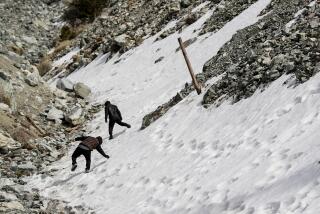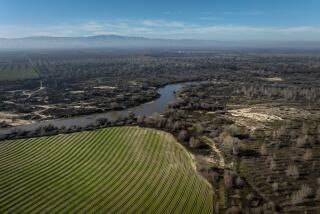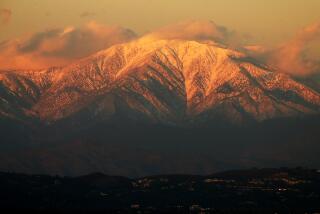Stranded up a creek
On a good day, Lytle Creek might attract 10,000 picnickers, RVers, Boy Scouts and day hikers.
But in early January, during a brief lull between storms, the popular recreation area in the San Bernardino National Forest wasn’t seeing too many guests — save for an undeterred weekend cave dweller.
For John Whitesell, a 55-year-old San Bernardino resident and trucking company vice president, a distant cavern at the south fork of Lytle Creek, north of Fontana, had become a weekend sanctuary, a place where he could escape the city and meditate in stillness.
Little did he know his quiet retreat would soon be in the middle of chaos.
Despite the prospect of a deluge, he set out for his hideaway on Jan. 7. Wearing flip-flops and a nylon rain suit that allowed him to wade up to his knees through multiple stream crossings, he made his usual two-mile trek up a canyon of boulders to his hole in the wall, 20 feet above a mild stream.
The soft-spoken hiker scrambled on all fours up a nearly sheer rock face and ducked into his home away from home, tall enough in places for him to stand in. He had a sleeping bag, a blanket and a stash of food, so even if the weather lived up to the warnings, he wasn’t worried.
“I knew there was going to be a big storm,” says Whitesell, who prefers to be addressed by his spiritual name, Shiva. “But I didn’t foresee a problem, because I’ve been to this cave every weekend for a couple of years, including during some rainstorms.”
On Saturday it poured on schedule, transforming Lytle Creek and its sodden tributaries into impassable 30-mile-per-hour torrents that washed out two bridges and large sections of road.
By Saturday night, it was also raining in the cave, the downpour seeping in through the roof. Shiva woke in the middle of the night to find a frigid pool of water rising toward his nose. Soon the flood was about two feet deep. “I was going to be underwater if I didn’t go outside,” he says.
Retreating to a raised ledge with an overhang just outside the cave, the hiker found himself pinned in a 2-by-3-foot patch of dirt wedged between a flooded cave and the edge of a 20-foot cliff. Below that was the streambed he’d hiked up in flip-flops, now a raging river fed by a relentless storm.
“I crossed my arms over my knees, put my forehead on my arms and tucked my sleeping bag around me like a cocoon. And that was basically the position I held for the next three days,” he says.
On Sunday morning, there was a glint of hope: He got a signal on his cellphone. He called his family, who alerted the Forest Service and the local fire department, who notified search-and-rescue at the San Bernardino County sheriff’s office.
But an air rescue was put on hold because of poor visibility. Ground rescues were attempted and abandoned miles below the cave at the flooded roadside.
“We couldn’t even get tractors and bulldozers past the floods several miles down the road just to assess the situation,” says fire captain Vernon Matthews, a Lytle Creek volunteer who was one of the first to counsel the cave camper over the phone. “I told him, whatever you do, protect your head and neck with that sleeping bag, because that’s where you’ll lose 80% of your body heat.”
“The main challenge was to keep from freaking out,” says Shiva. “Panic starts to come up. You just have this incredible urge to get up and run. But there was nowhere to run. It was a very intense test of my will to maintain sanity and not do something foolish and dangerous.”
Adding to the fear as he sat alone in the dark, on the ledge in the pouring rain at 3,200 feet, was the threat of an impending landslide. “I could hear the whole hillside loosening,” he said. During his wait for rescuers, Shiva prayed, recited affirmations and tried to regain body circulation while crunched in an unbearably confined space under a drenched sleeping bag.
Unlike some hikers who find themselves stuck in the wilderness, Shiva had made one very good decision: He’d left a topographic map behind with his family pinpointing his location. That saved a lot of search time.
Around midday on Monday, after close to 40 hours hunched on his haunches, Shiva peeked out of his sleeping bag. The sky was clear. Ecstatic, he called the sheriff’s office and asked to be picked up. They apologized and told him they were still fogged in and wouldn’t be able to get a helicopter off without at least a 600-foot ceiling.
“That hit me kind of hard,” he says. “Then it started pouring again.”
The food was disappearing, along with Shiva’s wits. “I definitely had the feeling that another couple days could very well prove disastrous. And I was looking at the possibility of another couple days, because I didn’t know if it was going to stop raining or not. Even when it stopped raining, I didn’t know for sure if they were going to be able to pull me out of there.”
But finally, on a bitterly cold but clear Tuesday morning, the stranded hiker got the call he’d been waiting for. Around 9 a.m., he heard a helicopter. The extremely grateful rescuee, down to one flip-flop, spent two nights in the hospital to monitor suspected minor frostbite on his feet.
Even after his lost weekend, though, Shiva has every intention of going back to his cave when he feels up to it, weather permitting. And in flip-flops.
“I don’t own a pair of shoes,” he notes. “I know it’s very unusual. But at the same time, that’s me. I like having more contact with the earth.”
He has learned a few lessons, though.
“I do intend to be more conscious about where I go and when I go,” he says, “even if it’s somewhere I’ve been many, many times before. This was probably the hardest thing I’ve ever had to go through in my entire life.”
More to Read
Start your day right
Sign up for Essential California for news, features and recommendations from the L.A. Times and beyond in your inbox six days a week.
You may occasionally receive promotional content from the Los Angeles Times.






